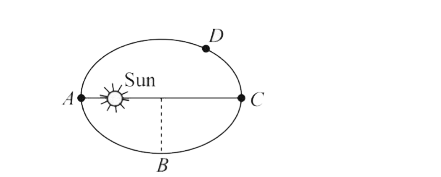A magnetic needle free to rotate in a vertical plane parallel to magnetic meridian has its north tip down at 60∘ with the horizontal. The horizontal component of earth's magnetic field at that place is 0⋅4G. Determine the magnitude of earth's magnetic field at the place.
To solve the problem, we need to determine the magnitude of the Earth's magnetic field at a location where the horizontal component of the magnetic field (Bh) is given, and the angle of dip (δ) is known.
1. Identify the Given Values:
- Horizontal component of Earth's magnetic field, BH=0.4G
- Angle of dip, δ=60∘
2. Understand the Relationship:
The relationship between the horizontal component of the Earth's magnetic field and the total magnetic field is given by:
BH=Bcos(δ)
where B is the magnitude of the Earth's magnetic field.
3. Rearrange the Formula:
To find B, we can rearrange the formula:
B=BHcos(δ)
4. Substitute the Known Values:
Now, substitute the values of BH and δ:
B=0.4Gcos(60∘)
5. Calculate cos(60∘):
We know that:
cos(60∘)=12
6. Perform the Calculation:
Substitute cos(60∘) into the equation:
B=0.4G12=0.4G×2=0.8G
7. Convert to Tesla:
Since 1G=10−4T, we convert the result:
B=0.8G=0.8×10−4T
Final Answer:
The magnitude of the Earth's magnetic field at that place is:
B=0.8GorB=0.8×10−4T
- Horizontal component of Earth's magnetic field, BH=0.4G
- Angle of dip, δ=60∘
The relationship between the horizontal component of the Earth's magnetic field and the total magnetic field is given by:
BH=Bcos(δ)
where B is the magnitude of the Earth's magnetic field.
To find B, we can rearrange the formula:
B=BHcos(δ)
Now, substitute the values of BH and δ:
B=0.4Gcos(60∘)
We know that:
cos(60∘)=12
Substitute cos(60∘) into the equation:
B=0.4G12=0.4G×2=0.8G
Since 1G=10−4T, we convert the result:
B=0.8G=0.8×10−4T
The magnitude of the Earth's magnetic field at that place is:
B=0.8GorB=0.8×10−4T
Topper's Solved these Questions
- XII BOARDSBOOK - XII BOARD PREVIOUS YEAR PAPER ENGLISHCHAPTER - XII BOARDSEXERCISE - SET-II, DELHI BOARD
4 Videos
- XII BOARDSBOOK - XII BOARD PREVIOUS YEAR PAPER ENGLISHCHAPTER - XII BOARDSEXERCISE - SET-III, DELHI BOARD
4 Videos
- XII BOARDSBOOK - XII BOARD PREVIOUS YEAR PAPER ENGLISHCHAPTER - XII BOARDSEXERCISE - SET -III
4 Videos
- SAMPLE PAPER 2019BOOK - XII BOARD PREVIOUS YEAR PAPER ENGLISHCHAPTER - SAMPLE PAPER 2019EXERCISE - SECTION D
6 Videos
Similar Questions
A magnetic needle free to rotate in a vertical plane parallel to the magnetic meridian has its north tip down at 60∘ with the horizontal.The horizontal component of the earth's magnetic field at the place is known to be 0.4G.Determine the magnitude of the earth's magnetic field at the place.
View SolutionA magnetic needle free to rotate in a vertical plane parallel to the magnetic meridian has its north tip pointing down at 22∘ with the horizontal. The horizontal component of the earth's magnetic field at the place is known to be 0⋅35G. Determine the strength of the earth's magnetic field at the place.
View Solution
Knowledge Check
The horizontal and vertical components of earth's magnetic field at a place are 0.3G and 0.52G. The earth's magnetic field and the angle of dip are
A0.3gandδ=30∘B0.4gandδ=40∘C0.5gandδ=50∘D0.6gandδ=60∘The vertical component of earth's magnetic field at a place is √3 times the horizontal component the value of angle of dip at this place is
A30∘B45∘C60∘D75∘
A magnetic needle free to rotate about the vertical direction (compass ) point 3.5 west of the geographic north . Another magnetic needle free to rotate in a vertical plane parallel to the magnetic meridian has its north tip pointing down at 18∘ with the horizontal . The magnitude of the horizontal component of the earth ' magnetic field at the place is known to be 0.40G . what is the direction and magnitude of the earth's magnetic field at the place ?
View SolutionThe horizontal and vertical components of earth's magnetic field at a place are 0.3G and 0.52G. The earth's magnetic field and the angle of dip are
View SolutionThe horizontal component of the earth's magnetic field is 3.6×10−5T where the dip is 60∘. Find the magnitude of the earth's magnetic field.
View SolutionThe vertical component of earth's magnetic field at a place is √3 times the horizontal component the value of angle of dip at this place is
View SolutionThe horizontal component of earth.s magnetic field On at a place is 1√3 times the vertical component. Determine the angle of dip at that place.
View SolutionA planet revolves around the sun in an elliptical orbit. The linear speed of the planet will be maximum at:

View Solution
